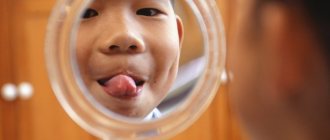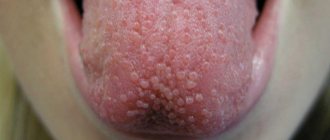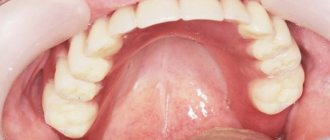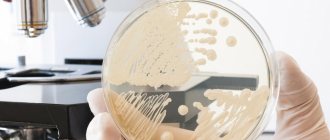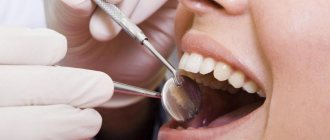November 23, 2017
The human tongue takes part in many processes. With its help, we determine the taste of food, use it for pronunciation and to help chew food. In addition, the tongue takes on the primary impact of bacteria. In addition, it is directly related to the gastrointestinal tract and signals digestive problems.
The tongue is an important human organ
UltraSmile.ru decided to look in detail at why the tip of the tongue hurts. Some of the reasons are completely harmless, but some may be a reason to consult a doctor.
Mini injury
In this case, the pain is explained by an external mechanical effect on the muscle fibers of the tongue. The reasons may be banal biting with teeth (while eating, in a state of increased nervousness, in the habit of biting the tongue or when falling), unsuccessful piercing, the presence of fillings and dentures that have damaging edges, as well as burns after drinking hot drinks.
A large number of nerve cells in the tongue provoke pain after injury, which intensifies while eating, talking, and even when touching the teeth or palate.
Mini tongue injury
If the injury is very serious and accompanied by bleeding, proceed as follows:
- tilt your head forward so that blood does not enter the stomach,
- Apply a gauze or cotton swab dipped in cold water to the wound, press firmly,
- cold compresses are recommended - every half hour for 2-3 minutes during the first day,
- To ensure the wound is clean, rinse your mouth with a saline solution several times a day, starting on the second day after the cut.
While the wound is healing, avoid hot, cold, or too hard foods. Be sure to follow developments. If the situation worsens (swelling and pus appear, body temperature rises, etc.), consult a doctor immediately. Mandatory consultation with a doctor is also indicated if the wound is too deep and long, it was caused by a puncture, or a foreign object remains at the site of damage.
Characteristics and types of pain, their causes
Coccydynia can be local in nature, affecting only the organ itself, or it can spread to the lower abdomen, back and lower back. Patients are concerned about pain in the tailbone when sitting, changing body position, etc. Depending on the source of the pathology, pain manifestations are divided into aching, stabbing and sharp.
Pain after injury
A blow to the buttocks or a fall leading to a fracture, crack, bruise, displacement are some of the possible reasons why the tailbone hurts. The injury causes a severe, acute attack of coccydynia in or near the organ. In a sitting position and while walking, its intensity increases.
Coccydynia is often immediate (it can be constant or paroxysmal), but there are cases when the symptom manifests itself after several years, in the form of severe burning pain.
Pain in the coccyx and lower back, sacrum
The combination of coccydynia with pain in the lower back and sacrum may indicate other diseases, for example, osteochondrosis, sciatica (pinched sciatic nerve), cysts localized in the lumbar and sacral spine.
Diseases of the rectum and hemorrhoids can also provoke coccydynia, associated with discomfort in the lower back and sacrum.
My tailbone hurts when I stand up
If the patient complains of coccydynia when standing up, then such a symptom indicates postoperative complications in the form of adhesions in the pelvic area or scars in the perineum. This type of pain is not related to pathologies of the spinal column.
In addition, mostly women may experience a lumbago when getting up from a seat, and a nagging pain while sitting. So why does the tailbone hurt in women when sitting? It is necessary to note the peculiarities of the female pelvic structure with more elastic ligaments and mobile articulation of bones. The tailbone hurts when sitting in women over 40 years old, leading a sedentary lifestyle, and athletes.
Pain in the tailbone when bending over
Coccydynia when bending over is a symptom of the presence of diseases localized near the organ:
- dysbacteriosis, colitis;
- cystitis;
- adnexitis or endometritis.
Pain radiating to the tailbone
Pain radiating to the coccygeal bone is typical for osteochondrosis, inflammation in the hip joints, pathologies of the rectum, and postoperative scars.
Pain above the coccyx
Inflammation of the nerve endings in the lumbar and sacral parts of the spinal column leads to pain above the coccygeal bone.
Pain under the tailbone
This type of coccydynia indicates prolapse of the perineum, diseases of the rectum, and long-standing spinal injuries. Pain under the coccygeal bone can also be bothersome due to scars in the anus area.
Aching and nagging pain in the coccyx
Often, aching and nagging coccydynia accompanies inflammation of the genital organs both in women (inflammation of the ovaries and fallopian tubes) and in men (prostatitis, prostate adenoma).
Constipation, hemorrhoids and osteochondrosis can also be factors that cause tailbone pain.
Pain in the tailbone during menstruation
Menstruation is often accompanied by pain in the coccyx; the causes in women lie both in natural processes in the uterus and in gynecological diseases or neurology. Natural causes include:
- contractions of the organ during menstruation, which cause pain radiating to the coccygeal bone;
- features of the structure and location of the genital organs associated with genetics;
- when the tailbone hurts during menstruation, the reasons for women may lie in the occurrence of internal edema. It is formed due to fluid retention associated with hormonal changes.
Severe pain in the coccygeal bone during menstruation can also indicate endometriosis, ovarian cyst and other gynecological pathologies, as well as neurological diseases (osteochondrosis, for example).
Coccyx pain in men
Among other reasons, sources of pain in men can be infectious diseases that lead to inflammation of the prostate and bladder. Coccydynia also occurs in males who are prone to a sedentary lifestyle due to work: for example, among taxi drivers, truck drivers, or, conversely, with excessive load on the coccygeal bone while driving a springless vehicle (“jeep disease”, leading to lack of treatment, to suppuration and fistula).
Pain in the tailbone during pregnancy and after childbirth
Pregnant women often complain of pain in the tailbone. There may be several reasons for this symptom:
- preparation for childbirth, accompanied by changes in the pelvic organs - the growth of the fetus and uterus leads to displacement of organs nearby and deviation of the coccygeal bone back;
- deficiency of calcium, which is the main nutrient for the skeletal system;
- pathologies of the reproductive organs;
- injuries.
The occurrence of coccydynia after the birth of a child indicates a birth injury, for example, a large fetus can lead to excessive extension of the organ.
Glossalgia
This term describes the occurrence of pain in the tip of the tongue for no apparent reason. Often accompanied by a feeling of dry mouth, itching, tingling, burning. Appears against the background of various problems with blood vessels and circulation, hormones, gastrointestinal tract, and during menopause. Basically, this condition develops with psychological disorders, depression and stress.
Glossalgia
Maintenance therapy consists of rinsing with herbal decoctions, performing pain-relieving applications, and rinsing the tongue with special medications prescribed by the doctor. But at the same time, it is worth calming the nervous system, since most often glossalgia is a psychological problem.
3. Glossitis
Glossitis should not be confused with glossalgia, since it is an inflammatory disease that affects the mucous membrane of the tongue. It is manifested by swelling and increased sensitivity of the entire surface. It is provoked by bacteria, viruses, that is, it is of infectious origin. In the absence of proper and timely treatment, it can lead to the appearance of ulcers, cracks and erosions. Main symptoms: burning, redness and enlargement of the tongue, increased salivation, difficulty eating and speaking.
Glossitis
The disease is treated with antiseptics and anesthetics applied locally. If necessary, the doctor prescribes anti-inflammatory drugs and antibiotics.
Organ structure
The tongue has 3 parts - the root, the body, and the apex. Each part is covered with epithelium and mucous membrane, the surface of which is equipped with various types of papillae (mushroom-shaped, filiform, groove-shaped, leaf-shaped).
- The entire surface of the organ is covered with filament papillae. Their structure resembles the shape of thin threads, which is why they got their name. The filament papillae do not have taste buds.
- Leaf-shaped papillae are located on the sides and back of the organ. They look like little folds. The leaf-shaped papillae have taste buds.
- The fungiform papillae are located in the center and at the top of the tongue. They are small red dots; taste buds are present in the epithelium of the fungiform papillae.
- The circumvallate papillae are located in the posterior part and in the body of the organ. Among all the others, the circumvallate papillae are the largest, but they also contain taste buds.
There are blood vessels throughout the muscle tissue of the tongue.
4. Stomatitis
The disease is characterized by inflammation of the oral mucosa, including the tongue. Main symptoms: the appearance of white spots or ulcers, swelling, increased sensitivity of the tip of the tongue, discomfort when eating, swallowing and talking. Treatment requires an integrated approach. It includes rinsing with herbal decoctions, the use of anti-inflammatory and antiseptic agents, which are prescribed by a doctor.
Stomatitis
Which doctor should I contact?
Professional oral hygiene is an integral part of dental health. To do this, you need to visit a hygienist regularly. It will remove plaque, hard deposits, and prevent caries. Diagnosis and treatment of oral diseases is carried out by general practitioners - pediatricians, therapists, dentists. When the need arises, the child is examined by gastroenterologists, infectious disease specialists, and neurologists.
During diagnosis, urine and blood tests are taken, and bacterial cultures of deposits from mucous tissues are carried out. Sometimes other tests are recommended. For pain and discomfort, the doctor prescribes painkillers and special baths. To avoid tissue irritation, coarse, hot, and salty foods are removed from the diet. Your child should not be given spicy foods. It is important to promptly treat diseased units and constantly maintain oral health.
Allergy
It manifests itself as redness and swelling of the mucous membrane due to contact with allergens. Their role may include: certain foods, drinks, toothpaste components, etc.
Important!
If there is an increase in the size of the tongue, you should immediately call an ambulance, as this may indicate the onset of an acute reaction, which can lead to swelling of the larynx and even respiratory arrest.
Treatment of allergies comes down to stopping contact with objects that cause a similar reaction. Antiallergic (antihistamine) drugs are also prescribed.
Allergy
Taking care of your tongue should become a daily habit like brushing your teeth. If you experience the slightest discomfort or pain, you should contact your dentist (or therapist) for help. Treatment largely depends on the correct diagnosis. A qualified specialist is able to determine the root cause and refer, if necessary, to a specialized doctor.
Notice
: Undefined variable: post_id in
/home/c/ch75405/public_html/wp-content/themes/UltraSmile/single-item.php
on line
45 Notice
: Undefined variable: full in
/home/c/ch75405/public_html/wp-content /themes/UltraSmile/single-item.php
on line
46
Rate this article:
( 1 ratings, average: 5.00 out of 5)
language
Pain in the sublingual area, at the root
How to relieve pain that appears in the far part of the tongue, at its very base? Before answering this question, let’s look at the most common causes of this symptom, and they can be as follows:
- glossalgia: pain is usually localized at the tip, but can sometimes occur at the base,
- allergies: literally any part of an organ can hurt,
- digestive system diseases,
- vitamin deficiency: pain is often accompanied by severe tingling.
This is what glossalgia looks like at the base of the tongue.
Cellulitis and abscess are considered serious prerequisites for the symptom in question. In this case, it is painful for the patient to open and close his mouth, a bad odor occurs, and the intensity of salivation increases. The tongue visibly swells, making it difficult for a person to speak and breathe. This requires urgent medical attention.
